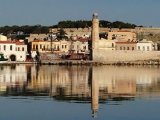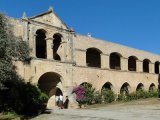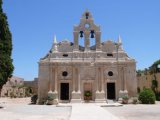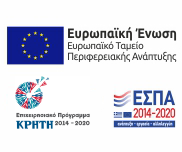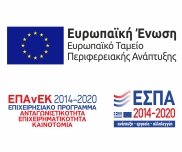Contemporary Art Museum of Crete:
Rethymnon Old Town
at 7.8km(W) from Adele Village & Beach
The Contemporary Art Museum of Crete was founded in 1992 as Municipal Gallery ‘L. Kanakakis'. It is housed in a Venetian building at the old city of Rethymno, below the Fortezza fortress and the Archaeological Museum. It houses a permanent exhibition of the work of Lefteris Kanakakis (oil paintings, sketches and aquarelles), thus representing all the stages of his achievements, as well as works of contemporary Greek artists, which cover a broad spectrum of modern Greek art as it has been accomplished from 1950 until today.
Ancient Eleftherna
The Museum of ancient Eleutherna - Homer in Crete, the first archaeological site museum in Crete, although smaller in size, is similar to those of Olympia, Delphi, and Vergina. The museum was created to house the results of the excavations carried out for thirty years in the ancient city of Eleutherna.
The originality of this museum is that the objects of the permanent exhibition will be updated periodically with new and older finds, so that the public's interest is continuous and relates to the discoveries and expansion of the excavation work on the site.
The exhibition will be accompanied by original and modern audiovisual exhibits.
The museum has complete and modern warehouses. Laboratories with modern and special equipment for conservation, design, photography, completion, reconstruction, documentation, and study of diversified material from excavations carried out in various locations of the archaeological site of Eleutherna.
For more information :Ancient Eleftherna
Arkadi Monastery :
Rethymno
at 8.2km(SE) from Adele Village & Beach
The Monastery of Arkádi (GR:Αρκάδι) constitutes a landmark of architecture and civilisation considering the magnificent façade of the church, the highly developed spiritual tradition as well as the flourishing development of fine arts. However, the holocaust, which took place in 1866, gave the monastery an eminent place in history, elevating it to an eternal symbol of freedom and heroism, which is acknowledged the world over.
The Monastery of Arkadi lies on a low plateau, 23 kilometres from the town of Rethymno.
Built during the last Venetian period, it consists of a large set of fortress-like buildings. The main building included the cells, the warehouses where the agricultural products were treated and stored, the stables. In a word, it was a well-equipped little fortress where people could find refuge in times of trouble.
The elaborate central entrance was restored just four years after the 1866 explosion. It leads to the interior court, through a vaulted passage. In the middle of the court, stands the impressive church, with its two naves dedicated to Saint Constantine and Saint Helen, and to Our Lord. Completed in 1587, its façade clearly shows the different currents in the development of Cretan art during the 16th and 17th centuries. In the south-west corner of the church, one can still see a section of the burnt iconostasis that survived the 1866 holocaust. The church is surrounded by a large and roomy precinct and the vaulted passages with their row of arches have retained their grandeur. The cells on the three sides of the court and the communal rooms on the north side are impressively austere.
The history of the monastery goes back to Byzantine times, when a monk, possibly named Arkadios, founded the monastery which in turn was named after him. Already in the 16th century the monastery played an important role in the cultural life of Crete. There were many copyist monks, a rich library and a school. The Turkish invasion reduced its cultural activities for a while, but the Arkadi Monastery was able to recover promptly and received a unique privilege among Greek monasteries: the Turks allowed the ringing of its bells.
The monastery proved to be not only a remarkable cultural centre, but also played an all-important role in the fight against the Turks: when the Turkish Army (15,000 men) surrounded the monastery in November 1866, 300 fighting men and 600 hundred women and children had taken refuge in it. When the walls came tumbling down and the Turks began the massacre, one of the rebels, Kostis Giamboudakis, blew up the powder magazine and the sky-high explosion reduced the monastery to a pile of rubble. This heroic feat is considered one of the greatest in Cretan history and has turned the Arkadi Monastery into one of Europe's Monuments to Freedom. There's a museum in the monastery with many impressive relics of the 1866 Holocaust and some beautiful icons. Many efforts have been made for the restoration of the monastery in the last years. Two monks live there. ;
Rethymnon Fortezza:
Rethymnon town
at 8.2km(W) from Adele Village & Beach
The Fortezza castle, at the top of a low hill named "Palaiokastro" dominates the town. It was built in 1590 to protect the city from the pirates raids and the Turks. The name "Palaiokastro which means 'The old Castle' was in use even by the Venetians which demonstrates the existance of an even older castle at this place. - Probably the acropolis of the ancient town of Rithymna. The interior of Fortezza accommodated the following basic buildings: the storeroom of the artillery, where canons and weapons were kept, the residence of the Councilors, where one of the city's two Venetian councilors lived, the residence of the Rector, which represented a luxurious, magnificent building in the central square of the fortress. Today parts of those buildings, as well as of some others built later, can be seen. The view from up there is magnificent, especially at night. The municipal theatre "Erofili" stands also at Fortezza's premises. It is an outdoor theatre that hosts almost all the performances during the Renaissance Festival.
Rethymno Archaeological Museum
: Rethymnon Old Town
at 8km(W) from Adele Village & BeachSince 1991, the Archaeological Museum of Rethymnon has been housed in the pentagonal building opposite the main gate of the Fortezza. The building was constructed by the Turks in an effort to strengthen the city's defense. Due to the different functions that it served over the centuries - until the 1960's it housed the civic prison - its original form has been significantly altered.
The museum contains the following collections:- Late Neolithic (3500-2900 B.C.) and Early Minoan (2800-2100 B.C.) finds from the caves Gerani, Melidoni, Margeles and Helenes
- finds from the buildings at Apodoulou, Monastiraki and the peak sanctuary at Vrysinas, dated to the Middle Minoan period (2100-1600 B.C.)
- Late Minoan finds (1600-1100 B.C.) from the cemeteries, the most representative being that of Armenoi
- finds of the Geometric (1000-700 B.C.) and Archaic (700-500 B.C.) periods from Eleutherna and Axos
- finds from Stavromenos and Argyroupolis (ancient Lappa) dated to the Classical, Hellenistic and Roman periods.




